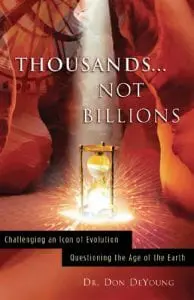Why should you believe in creation, and not evolution? I mean, scientifically speaking. Haven’t we proven that evolution is a fact?
For there to be any hope that evolution happened, our earth must be millions and billions of years old. After all, without millions of years, there’s no way that an amoeba, frog, or fish had time to evolve into a man. Now, many people mistakenly appeal to carbon-14, or C-14, dating to support the supposed old ages that evolution requires. But C-14 dating isn’t actually used to date things that are thought to be millions of years old.
That’s because C-14 doesn’t last very long. It decays away rapidly. If our whole earth were made of nothing but C-14 atoms, after just one million years, there would be nothing left! Okay, so no evolutionary scientist expects to find C-14 in a fossil they believe is millions of years old.
Carbon 14 can be detected using an incredibly accurate and high-tech machine called an accelerator mass spectrometer, or AMS. Now, these machines have to be checked occasionally to make sure that they are not picking up any background contamination from the laboratory. Rock samples that supposedly contain zero C-14 (like fossils, coal, and limestone) are used for the test.
The problem? Labs began realizing that the test samples had measurable amounts of C-14 in it! So, the scientists concluded that the samples all must have been contaminated somehow, even if they had been thoroughly prepared for the test to ensure no contamination. Interestingly, a blank sample measured zero C-14, so it wasn’t a machine error!
The conclusion that these scientists refused to consider was that the rock and fossil samples were not millions of years old. And yet, how else do you explain C-14 in supposedly old rocks and fossils? It shouldn’t be there if the ages are even remotely accurate.
But the problem gets even worse for old-earth evolution. Diamonds are considered by secular geologists to be billions of years old. They are the hardest natural substance and so they resist contamination. Diamonds are formed over one hundred miles below the surface and are brought up extremely quickly by “pipes.” It’s nearly impossible that diamonds could be contaminated by any foreign C-14 and there shouldn’t be any intrinsic to the diamonds if they are billions of years old.
Well, C-14 has been found in diamonds! This C-14 has to be part of their original composition when they were formed deep in the Earth. But it can’t last a million years, let alone a billion! This is a huge problem for secular geologists, who believe dates of billions of years. They believe in their theory despite science in the lab giving conflicting data.
When we start with God’s Word, these findings make perfect sense. According to the Biblical record, the Earth is only a few thousand years old. Diamonds, probably part of the original creation rock, are only 6,000 years old, so C-14 has no problem lasting over this amount of time. And the majority of fossils and rock layers were formed during Noah’s Flood around 4,000 years ago so it’s no surprise they have C-14 in them. The observational evidence doesn’t support millions of years, and without the millions of years, there’s no chance whatsoever that evolution has happened.
Just one more scientific reason that you shouldn’t believe in geological evolution. It takes a LOT of faith.
I’m David Rives, Truly, the Heavens Declare the Glory of God.
LIKE David’s FB page here: http://www.facebook.com/DavidRivesMinistries
FOLLOW us on Twitter: http://twitter.com/TheDavidRives
VISIT our official website for tons of free information: http://www.davidrivesministries.org
David Rives MUSIC: http://www.davidrivesmusic.com
For the TBN show “Creation in the 21st Century”: http://www.creationinthe21stcentury.com
 Thousands . . . Not Billions
Thousands . . . Not Billions
The age of the earth is one of the most divisive topics today, much debated by scholars and laypersons alike. What one believes about the age of the earth goes a long way in determining world views. The Bible is explicit that the earth is young, but many people feel that science has proved our planet is more than four billion year old. Thousands…Not Billions provides a compelling challenge to Darwinian evolution.
- Why do conventional methods for dating rocks differ so radically?
- What does carbon-14 found in diamonds tell us?
- Was there accelerated nuclear decay in earth’s history?
- Are the creation and Flood accounts genuine historic events?
These and many other questions are addressed in Thousands…Not Billions. This book summarizes eight years of research by the Institute for Creation Research (ICR) and a team of scientists, whose goal was to explore the age of the earth from a biblical perspective. The project title was Radioisotopes and the Age of The Earth, or RATE.





